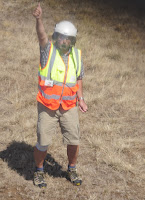It’s hard work to get good data
At some days, it is
particularly hard work to get good data. Today was such a day. As the weather
was still promising after the morning flight, we decided to have a second
flight in the afternoon. Some stratocumulus cloud fields were present, so we
cloud people wanted to go for catching some of them.
 The plan was to start
directly after lunch break, but while sweating in the helicopter, we had to
wait for the controller to finish lunchtime as well. Then, after starting the
engines, a beep and a red light indicated a problem with one of the two power generators. The heli can fly with only one generator and a battery as backup, but the ACTOS data monitoring had switched to battery mode.
Finally, after the usual start procedure “HELIOS airborne – continue climbing
– ACTOS airborne” the ground crew noticed, that ACTOS wasn’t pointing into
the direction of flight, so we decided to return to the airfield. The ground
crew couldn’t find any suspicious failures and ACTOS was flying in a normal way
again, so finally we could begin our measurement flight.
The plan was to start
directly after lunch break, but while sweating in the helicopter, we had to
wait for the controller to finish lunchtime as well. Then, after starting the
engines, a beep and a red light indicated a problem with one of the two power generators. The heli can fly with only one generator and a battery as backup, but the ACTOS data monitoring had switched to battery mode.
Finally, after the usual start procedure “HELIOS airborne – continue climbing
– ACTOS airborne” the ground crew noticed, that ACTOS wasn’t pointing into
the direction of flight, so we decided to return to the airfield. The ground
crew couldn’t find any suspicious failures and ACTOS was flying in a normal way
again, so finally we could begin our measurement flight.
As usual, we started
to record a vertical profile up to 7000ft, where we already fly inside the free
troposphere. We encountered some single cumulus clouds in 700m, then a
stratocumulus cloud layer in 1100m with clear skies above. The temperature
inversion of 5K was just above the SC clouds with a nearly constant temperature
up to our maximum altitude. Here, we flew one 15 minutes leg to gather data in
the free troposphere with the aim to compare it to data from mount Pico (last
chance today!).
Before every flight,
we work out a flight pattern to follow, but being airborne, we constantly have
to review and adapt our plan. For that purpose, the ACTOS data monitoring
system provides us a camera stream and information about altitude, temperature,
liquid water content and particle concentration. Besides those parameters, we
have to take into account the limitations from the pilot’s point of view like minimum
flight speed and the 10nm sector around the airport. Due to running on battery,
we encountered some interruptions in the data monitoring. Therefore, at some
points the only way to find out if ACTOS is inside the cloud was to open the
door and have a look outside. You see, the workload is quite high anyways for
both the pilots and the scientists, and the issues demand all your concentration.
.
ACTOS data monitoring and the helicopter instruments help us
We descended until
ACTOS was flying inside the SC clouds and tried to measure there. But the SC
field was thinning out, with an maximum LWC of just 0.3 g/m3 and cloud holes getting
bigger. We decided to leave our East-West flight pattern and veer to the north,
where we spotted a promising SC cloud field. Flying against the wind, it felt
like hours to reach the clouds, but we arrived there just inside the 10nm zone.
This decision turned out to be a good one, we found a fascinating SC cloud with
a highly dynamical and inhomogeneous cloud top, LWC up to 1 g/m3 and a vertical
extend of about 130m. We spent 15 minutes measuring inside and at the cloud tops
and finished with some porpoise dives from cloud base up to the free
troposphere. Here, we discovered another interesting feature: just above the
inversion layer, particle concentration showed a peak. Before we ran out of
fuel, our cloud field also started to decay and we returned happily to the
airfield.
 |
| Our SC cloud field |
We are very confident
about this flight. Despite all the issues, we could complete our plan and
record some valuable data.
posted by Ulrike
pictures by Holger




Kommentare
Kommentar veröffentlichen